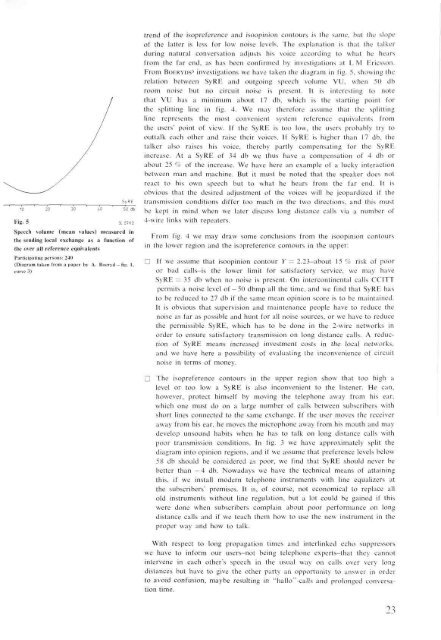1 - History of Ericsson - History of Ericsson
1 - History of Ericsson - History of Ericsson
1 - History of Ericsson - History of Ericsson
You also want an ePaper? Increase the reach of your titles
YUMPU automatically turns print PDFs into web optimized ePapers that Google loves.
trend <strong>of</strong> the isopreference and isoopinion contours is the same, but the slope<br />
<strong>of</strong> the latter is less for low noise levels. The explanation is that the talker<br />
during natural conversation adjusts his voice according to what he hears<br />
from the far end, as has been confirmed by investigations at L M <strong>Ericsson</strong>.<br />
From BOERYDS 5 investigations we have taken the diagram in fig. 5, showing the<br />
relation between SyRE and outgoing speech volume VU, when 50 db<br />
room noise but no circuit noise is present. It is interesting to note<br />
that VU has a minimum about 17 db. which is the starting point for<br />
the splitting line in fig. 4. We may therefore assume that the splitting<br />
line represents the most convenient system reference equivalents from<br />
the users' point <strong>of</strong> view. If the SyRE is too low, the users probably try to<br />
outtalk each other and raise their voices. If SyRE is higher than 17 db, the<br />
talker also raises his voice, thereby partly compensating for the SyRE<br />
increase. At a SyRE <strong>of</strong> 34 db we thus have a compensation <strong>of</strong> 4 db or<br />
about 25 % <strong>of</strong> the increase. We have here an example <strong>of</strong> a lucky interaction<br />
between man and machine. But it must be noted that the speaker does not<br />
react to his own speech but to what he hears from the far end. It is<br />
obvious that the desired adjustment <strong>of</strong> the voices will be jeopardized if the<br />
transmission conditions differ too much in the two directions, and this must<br />
be kept in mind when we later discuss long distance calls via a number <strong>of</strong><br />
4-wire links with repeaters.<br />
From fig. 4 we may draw some conclusions from the isoopinion contours<br />
in the lower region and the isopreference contours in the upper:<br />
• If we assume that isoopinion contour Y — 2.23-about 15 % risk <strong>of</strong> poor<br />
or bad calls-is the lower limit for satisfactory service, we may have<br />
SyRE = 35 db when no noise is present. On intercontinental calls CCITT<br />
permits a noise level <strong>of</strong>- 50 dbmp all the time, and we find that SyRE has<br />
to be reduced to 27 db if the same mean opinion score is to be maintained.<br />
It is obvious that supervision and maintenance people have to reduce the<br />
noise as far as possible and hunt for all noise sources, or we have to reduce<br />
the permissible SyRE, which has to be done in the 2-wire networks in<br />
order to ensure satisfactory transmission on long distance calls. A reduction<br />
<strong>of</strong> SyRE means increased investment costs in the local networks,<br />
and we have here a possibility <strong>of</strong> evaluating the inconvenience <strong>of</strong> circuit<br />
noise in terms <strong>of</strong> money.<br />
3 The isopreference contours in the upper region show that too high a<br />
level or too low a SyRE is also inconvenient to the listener. He can,<br />
however, protect himself by moving the telephone away from his ear,<br />
which one must do on a large number <strong>of</strong> calls between subscribers with<br />
short lines connected to the same exchange. If the user moves the receiver<br />
away from his ear, he moves the microphone away from his mouth and may<br />
develop unsound habits when he has to talk on long distance calls with<br />
poor transmission conditions. In fig. 3 we have approximately split the<br />
diagram into opinion regions, and if we assume that preference levels below<br />
58 db should be considered as poor, we find that SyRE should never be<br />
better than - 4 db. Nowadays we have the technical means <strong>of</strong> attaining<br />
this, if we install modern telephone instruments with line equalizers at<br />
the subscribers' premises. It is, <strong>of</strong> course, not economical to replace all<br />
old instruments without line regulation, but a lot could be gained if this<br />
were done when subscribers complain about poor performance on long<br />
distance calls and if we teach them how to use the new instrument in the<br />
proper way and how to talk.<br />
With respect to long propagation times and interlinked echo suppressors<br />
we have to inform our users-not being telephone experts-that they cannot<br />
intervene in each other's speech in the usual way on calls over very long<br />
distances but have to give the other party an opportunity to answer in order<br />
to avoid confusion, maybe resulting in "hallo"-calls and prolonged conversation<br />
time.
















